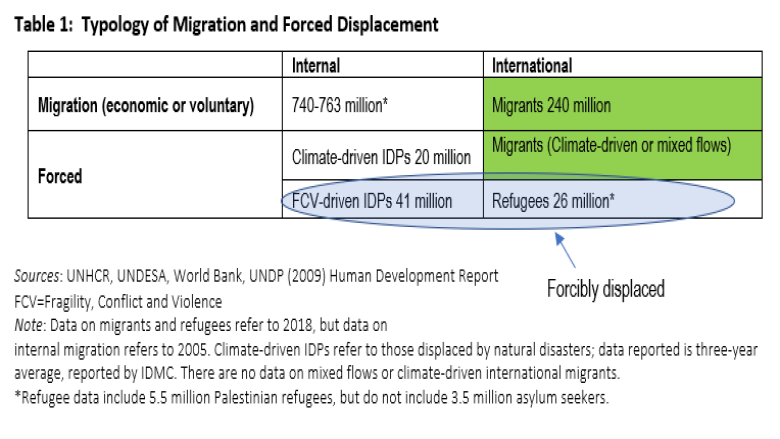This publication describes how economic migration can be leveraged for development and what role could the World Bank Group and other MDBs play in that process. It provides an update on migration data for the period 2000-18, and on migration’s drivers and impacts referencing relevant literature; discusses changes in the international governance surrounding migration during 2017-19, including the adoption of the Global Compact on Migration; and suggests areas of activities for international financial institutions. Also, it provides a template for migration diagnostics in sending, receiving, and transit countries.
Several important stylized facts are presented in the paper. For example, the typology surrounding forced and voluntary (or economic) migration, and that surrounding internal and international migration is often misunderstood or misrepresented. Whether it is internal or international, economic migration is significantly larger than forced migration (See Table 1).
This paper was presented to the WBG Board on July 16th, 2019, in response to an earlier paper which was presented to the Board three years ago at the peak of the refugees and migrants crisis in mid-2016. Since then, the global migration context has changed rather dramatically, with migration policies becoming more restrictive even as the evidence from academic literature has shown the more beneficial aspects of migration. This is in part due to the fact that immigration has risen in the high-income countries - in high-income OECD countries.
This report highlights recent changes in international governance of migration including the Global Compact on Migration and the Global Compact on Refugees, and a UN Network on Migration established to support implementation of the first.
Viewing migration through a development lens can suggest promising ways to deploy the World Bank Group’s knowledge, finance, and convening power to catalyze collective action to address migration at the global, regional, national, and local levels. IDA18 includes a commitment to view systematic country diagnostics (SCDs) through a migration lens in countries where migration or remittances are significant. The treatment of migration under IDA19 is expected to be even more prominent than under IDA18. The paper also presents recent WBG activities on migration and has identified four broad areas for World Bank Group involvement in migration programs beyond its other activities that may affect migration:
- supporting safe and regular (legal) labor mobility,
- supporting the migration-related indicators specified in the Sustainable Development Goals (reducing recruitment costs paid by migrant workers, reducing remittance costs, leveraging remittances, and mobilizing diaspora resources for development),
- generating knowledge for policy making, and
- supporting global partnerships.
Please read the entire Board Paper for more information or go to KNOMAD.ORG for more information on migration and remittances. A Video record of the Presentation of the Paper is also available.
